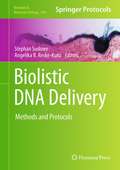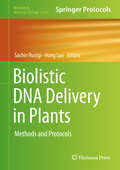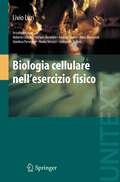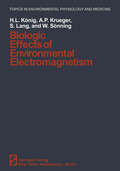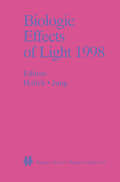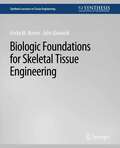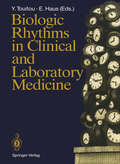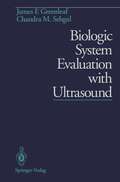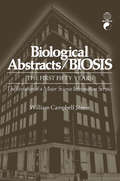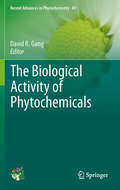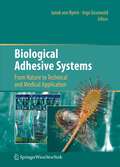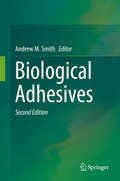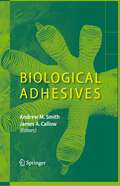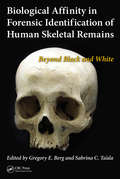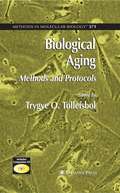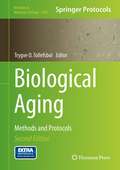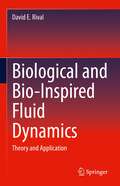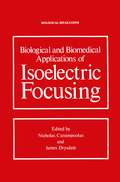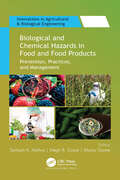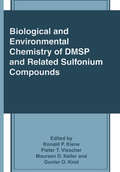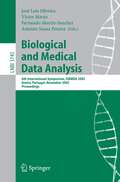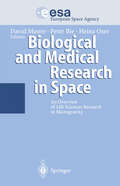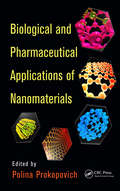- Table View
- List View
Biolistic DNA Delivery: Methods and Protocols (Methods in Molecular Biology #940)
by Stephan Sudowe and Angelika B. Reske-KunzBiolistic transfection represents a direct physical gene transfer approach in which nucleic acids are precipitated on biologically inert high-density microparticles (usually gold or tungsten) and delivered directly through cell walls and/or membranes into the nucleus of target cells by high-velocity acceleration using a ballistic device such as the gene gun. Biolistic DNA Delivery: Methods and Protocols provides a comprehensive collection of detailed protocols intended to provide the definitive practical guide for the novice as well as for the advanced gene transfer expert on how to introduce nucleic acids into eukaryotic cells using the biolistic technique. Split into six convenient sections, this detailed volume covers biolistic gene transfer into plants, nematodes, and mammalian cells, both in vitro and in vivo, as well as the use of gene gun-mediated DNA vaccination in various experimental animal models of human diseases, and the description of biolistic delivery of molecules other than nucleic acids. Written in the highly successful Methods in Molecular Biology™ series format, chapters include introductions to their respective topics, lists of the necessary materials and reagents, step-by-step, readily reproducible laboratory protocols, and tips on troubleshooting and avoiding known pitfalls. All-inclusive and cutting-edge, Biolistic DNA Delivery: Methods and Protocols brings together the knowledge and the experience of leading experts in the field of gene transfer in order to serve all researchers who wish to further our abilities in this vital field.
Biolistic DNA Delivery in Plants: Methods and Protocols (Methods in Molecular Biology #2124)
by Hong Luo Sachin RustgiThis volume details protocols for the use of the biolistic DNA delivery method in different plant species. Chapters guide readers through non-protocol chapters that cover relevant topics of interest, a broad overview of the field, exciting modifications of the system, and reliable plant transformation procedures in different plant species. Written in the highly successful Methods in Molecular Biology series format, chapters include introductions to their respective topics, lists of the necessary materials and reagents, step-by-step, readily reproducible laboratory protocols, and tips on troubleshooting and avoiding known pitfalls. Authoritative and cutting-edge, Biolistic DNA Delivery: Methods and Protocols aims to provide a comprehensive collection of protocols to intended to be a practical guide for the novice as well as the advanced user in the field of plant genetic transformation.
Biologen in der Industrie: Ein virtuelles Praktikum
by Tilman Achstetter Gerd KlöckDer Weg in die Grundlagenforschung steht nur wenigen Absolventen von Biologiestudiengängen offen. Die meisten Biologen orientieren sich daher in der Wirtschaft. Die Autoren zeigen in diesem Buch in Form eines virtuellen Praktikums in der fiktiven Firma „TiGer BioTec" auf, welche Aufgaben Biologen, aber auch andere Naturwissenschaftler in der freien Wirtschaft erwarten können. Das Buch veranschaulicht in einem Planspiel mit Praxisbeispielen und Übungsaufgaben Aspekte der Marktrecherche, Informationsbeschaffung, sowie der Produktentwicklung, und gibt einen Einblick in die Bedeutung von Projektmanagement und Qualitätssicherung. Das Buch wendet sich an Biologen und andere Naturwissenschaftler, die eine Alternative zur Tätigkeit in der Grundlagenforschung suchen. Es ist eine wertvolle Orientierungshilfe für Lehrer wie Schüler von Gymnasien, Fachschulen, und Berufsakademien, welche sich ein praxisnahes Bild vom Beruf des Naturwissenschaftlers machen wollen.
Biologia cellulare nell'esercizio fisico
by Livio LuziLa nascita delle Facoltà e dei Corsi di Laurea di Scienze Motorie, e la chiusura degli ISEF, hanno prodotto un radicale mutamento degli insegnamenti della nuova Facoltà Universitaria. In particolare, i percorsi di formazione degli insegnamenti forniti da Scienze Motorie, a seguito delle due riforme che si sono succedute nell’ultimo decennio, si sono notevolmente arricchiti di materie teoriche sia di base che applicate a problematiche del movimento umano. La Biologia Applicata è sicuramente tra i nuovi insegnamenti quello che più di altri caratterizza la differenza tra i corsi ISEF e le nuove classi di Laurea universitarie inerenti lo sport. A questo riguardo, esisteva quindi una lacuna formativa e comunicativa nel campo della Biologia Applicata che andava colmata con la preparazione di questo manuale che, senza la pretesa di essere esaustivo nel settore della Biologia, tratta in dettaglio gli argomenti di Biologia rilevanti per l’attuale percorso formativo didattico dello studente di Scienze Motorie, con particolare attenzione agli eventi endocellulari che determinano, regolano e modulano l’esercizio fisico. Oltre all’utilizzo da parte degli studenti di Scienze Motorie, per i quali questo libro è stato scritto, professionisti e operatori nel settore dello sport e del tempo libero possono trarre vantaggio dalla sua lettura. Il presente volume è frutto di un lavoro di équipe o, se si preferisce, dell’esperienza di una Scuola che da circa 30 anni si è occupata di ricerca nel settore del metabolismo, della endocrinologia e della fisiologia dello sport.
Biologic Effects of Environmental Electromagnetism (Topics in Environmental Physiology and Medicine)
by H. L. König A. P. Krüger S. Lang W. SönningARCHIVE COpy DO NOT REMOVE The public in industrialized countries shows a mounting concern about biological effects of electrical and magnetic fields. As a result, experimental studies on this subject are being published in increasing numbers throughout the world. Prof. H. L. Konig, of the Technical University of Munich, West Germany, a leading expert and pioneer in this field, has written an authoritative text in a lucid style which makes the material also accessible to lay readers. The book describes the effects of natural as well as artificial electromagnetic energies covering the en tire measurable frequency range from the highest frequencies, x-rays, through microwaves, radio waves, and finally extremely low frequency (ELF) waves. Cit ing the evidence from scientific studies in various countries, Konig also appraises the biologic effects of microwaves and high tension power lines, which have become controversial issues in recent years. Other contributions to the book have been made by Prof. Albert P. Krueger, University of California, Berkeley, on air ionization effects and by the mete orologist Walter Sonning on biometeorology, documenting the influence of atmo spheric electrical currents on health and disease. Moreover, the late Dr. Siegnot Lang, a former coworker of Dr. Konig, has contributed to this book.
Biologic Effects of Light 1998: Proceedings of a Symposium Basel, Switzerland November 1–3, 1998
by Ernst G. Jung Michael F. HolickIt is remarkable how much we take for granted the tremendous energy and vitality that the sun provides earth's inhabitants. As we enter the new millennium, it is worthwhile to review how our ancestors perceived the biologic effects of sunlight, and how science and medicine have advanced our knowledge about the biologic effects of light. At the turn of the century, a multitude of investigators explored the use of sunlight and artificial radiation for treating a multitude of diseases. These explorations gave rise to photodynamic therapy, phototherapy, and chemophototherapy. However, enthusiasm for using sunlight and artificial radiation to treat disease was dampened with the birth of pharmacology. It was the goal of the Fifth International Arnold Rikli Symposium on the Biologic Effects of Light, held in Basel, Switzerland, on November 1-3, 1998, to review the history of phototherapy and have some of the world's leading experts on the biologic effects of light provide new perspectives on the positive and negative effects of light. The general topics included a broad range of biologic effects of sunlight, artificial ultraviolet radiation and electromagnetic radiation. Special sessions on radiation and vitamin D and bone health, photoimmunology, biopositive effects of UV radiation, effects of electromagnetic currents and fields, and ocular and non-ocular regulation of circadian rhythms and melatonin, should be of particular interest to readers of Biologic Effects of Light.
Biologic Foundations for Skeletal Tissue Engineering (Synthesis Lectures on Tissue Engineering)
by Ericka Bueno Julie GlowackiTissue engineering research for bone and joint applications entails multidisciplinary teams bringing together the needed expertise in anatomy, biology, biochemistry, pathophysiology, materials science, biomechanics, fluidics, and clinical and veterinary orthopedics. It is the goal of this volume to provide students and investigators who are entering this exciting area with an understanding of the biologic foundations necessary to appreciate the problems in bone and cartilage that may benefit from innovative tissue engineering approaches. This volume includes state-of-the-art information about bone and cartilage physiology at the levels of cell and molecular biology, tissue structure, developmental processes, their metabolic and structural functions, responses to injury, mechanisms of post-natal healing and graft incorporation, the many congenital and acquired disorders, effects of aging, and current clinical standards of care. It reviews the strengths and limitations of various experimental animal models, sources of cells, composition and design of scaffolds, activities of growth factors and genes to enhance histogenesis, and the need for new materials in the context of cell-based and cell-free tissue engineering. These building blocks constitute the dynamic environments in which innovative approaches are needed for addressing debilitating disorders of the skeleton. It is likely that a single tactic will not be sufficient for different applications because of variations in the systemic and local environments. The realizations that tissue regeneration is complex and dynamic underscore the continuing need for innovative multidisciplinary investigations, with an eye to simple and safe therapies for disabled patients. Table of Contents: Introduction / Structure and Function of Bone and Cartilage Tissue / Development / Responses to Injury and Grafting / Clinical Applications for Skeletal Tissue Engineering / Animal Models / Tissue Engineering Principles for Bone and Cartilage / Perspectives
Biologic Rhythms in Clinical and Laboratory Medicine
by Yvan Touitou Erhard HausEveryone has heard of nature's "biological clocks", the phenomenon of periodic activity in plants, animals and humans. But what does chronobiology have to do with modern medicine? This book presents in a concise but comprehensive fashion the basic principles of chronobiology and their application to clinical medicine. The chapters are written by specialists in the field; they summarize the physiology, pathophysiology and pathology of the human time structure and outline the application of chronobiologic principles and techniques for diagnosis and treatment.
Biologic System Evaluation with Ultrasound
by James F. Greenleaf Chandra M. SehgalBiologic System Evaluation with Ultrasound is a reference book for engineers in the field of ultrasonics and is intended to inform those unfamiliar with current methods of ultrasonic analysis. Explaining the mathematical and physical principles of ultrasound imaging of living tissue with effective precision, the book encompasses the following topics: relationships between the biological and scattering hierarchies; graphic description of scattering; class 1,2,3,4 scattering and their association with the biological hierarchy; instruments used for biologic system evaluation; computed tomographic methods of imaging. The authors have provided an effective explanation of the ultrasound scattering of image and image acquisition that will benefit engineers, physicists, and radiologists alike.
Biological Abstracts / BIOSIS: The First Fifty Years. The Evolution of a Major Science Information Service
by William SteereA fiftieth birthday is a good one to celebrate-old enough to be ex perienced and mature, but not so old as to be an antique. And if the fifty years have spanned as much change in scientific affairs as has occurred during the lifetime of Biological Abstracts it is surely time for a stocktaking. The leaders of biology in 1926 simply could not have imagined the condi tions of 1976. And few biologists active in 1976 can imagine what 1926 was like. That was before the explosive growth of federal funds for research and development, before the huge swelling of graduate enrollments and degrees, before World War II, even before the Great Depression! A few old-timers can remember 1926, and Bill Steere will forgive me for calling him an old-timer. After all, he provides the evidence himself; as a graduate student he met the first editor when Biological Abstracts was only three years old, and he has known all its later editors and administra tive officers. What he does not say is that tn length of service to BIOSIS, in seniority, he stands among only a few past and present members of the board of trustees; nor does he mention that at least as frequently as any other biologist he has been called upon to serve on governmental and associational councils and committees dealing with policy and strategy concerning the abstracting, classification, and dissemination of scientific knowledge. Surely he was the right choice to write this history.
The Biological Activity of Phytochemicals (Recent Advances in Phytochemistry #41)
by David R. GangThis is the first volume to be published under a new series agreement for Recent Advances in Phytochemistry, co-published with the Phytochemical Society of North America.
Biological Adhesive Systems: From Nature to Technical and Medical Application
by Janek Byern Ingo GrunwaldJ. Herbert Waite Like many graduate students before and after me I was There are so many species about which nothing is known, mesmerized by a proposition expressed years earlier by and the curse of not knowing is apathy. Krogh (1929) – namely that “for many problems there is Bioadhesion is the adaptation featured in this book, an animal on which it can be most conveniently studied”. and biology has many adhesive practitioners. Indeed, This opinion became known as the August Krogh Prin- every living organism is adhesively assembled in the ciple and remains much discussed to this day, particu- most exquisite way. Clearly, speci? c adhesion needs to larly among comparative physiologists (Krebs, 1975). be distinguished from the opportunistic variety. I think The words “problems” and “animal” are key because of speci? c adhesion as the adhesion between cells in the they highlight the two fundamental and complementary same tissue, whereas opportunistic adhesion might be the foci of biological research: (1) expertise about an animal adhesion between pathogenic microbes and the urinary (zoo-centric), which is mostly observational and (2) a tract, or between a slug and the garden path. If oppor- mechanistic analysis of some problem in the animal’s life nistic bioadhesion is our theme, then there are still many history or physiology (problem-centric), which is usually practitioners but the subset is somewhat more select than a hypothesis-driven investigation. before.
Biological Adhesives
by Andrew M. SmithMany creatures use adhesive polymers and structures to attach to inert substrates, to each other, or to other organisms. This is the first major review that brings together research on many of the well-known biological adhesives dealing with bacteria, fungi, algae, and marine and terrestrial animals. As we learn more about their molecular and mechanical properties we begin to understand why they adhere so well and with this comes broad applications in areas such as medicine, dentistry, and biotechnology.
Biological Adhesives
by Andrew M. Smith James A. CallowMany creatures use adhesive polymers and structures to attach to inert substrates, to each other, or to other organisms. This is the first major review that brings together research on many of the well-known biological adhesives dealing with bacteria, fungi, algae, and marine and terrestrial animals. As we learn more about their molecular and mechanical properties we begin to understand why they adhere so well and with this comes broad applications in areas such as medicine, dentistry, and biotechnology.
Biological Affinity in Forensic Identification of Human Skeletal Remains: Beyond Black and White
by Gregory E. Berg Sabrina C Ta'AlaAncestry determination in the identification of unknown remains can be a challenge for forensic scientists and anthropologists, especially when the remains available for testing are limited. There are various techniques for the assessment of ancestry, ranging from traditional to new microbiological and computer-assisted methods. Biological Affinity
Biological Aging: Methods and Protocols (Methods in Molecular Biology #371)
by Trygve O. TollefsbolThis book investigates the various processes that are affected by the age of an organism. Several new tools for the analysis of biological aging have been introduced recently, and this volume provides methods and protocols for these new techniques in addition to its coverage of established procedures. Researchers seeking new technology and techniques will find this volume of tremendous benefit as they move towards new directions.
Biological Aging: Methods and Protocols (Methods in Molecular Biology #1048)
by Trygve O. TollefsbolThe second edition of Biological Aging: Methods and Protocols expands upon the previous edition with current, detailed, useful and promising methods currently available to study aging. With new chapters on protocols that detail aging cell culture as well as many more contemporary approaches such as nuclear transfer, microarray and proteomics technologies. Written in the highly successful Methods in Molecular Biology series format, chapters include introductions to their respective topics, lists of the necessary materials and reagents, step-by-step, readily reproducible laboratory protocols, and key tips on troubleshooting and avoiding known pitfalls. Authoritative and practical, Biological Aging: Methods and Protocols, Second Edition details the most recent breakthroughs in technology that have served to advance the study of aging.
Biological and Bio-Inspired Fluid Dynamics: Theory and Application
by David E. RivalThis text provides the reader with tools necessary to study biological and bio-inspired flows, all the while developing an appreciation for their evolutionary and engineering constraints. It is suitable for students already exposed to introductory concepts in fluid mechanics and applied mechanics as a whole, but who would not need an advanced training in fluid mechanics per se. Currently no textbook exists that can take students from an introductory position in fluid mechanics to these contemporary topics of interest. The book is ideal for upper-level undergraduates and graduate students studying a range of engineering domains as well as biology, or even medicine.
Biological and Biomedical Applications of Isoelectric Focusing (Biological Separations)
by Nicholas CatsimpoolasBiological and Chemical Hazards in Food and Food Products: Prevention, Practices, and Management (Innovations in Agricultural & Biological Engineering)
by Santosh K. Mishra Megh R. Goyal Manju GaareThis volume takes an in-depth look at various biological and chemical hazards in food and food products that pose health threats. It also outlines methods and practices for the diagnosis, prevention, and management of these hazards in food production processes. The new scientific research and case studies presented in the volume cover mycotoxins, foodborne pathogens, antibiotic residues from dairy animals, pesticide residues, the presence of heavy metals in food, and more. Chapters also address food allergy management and offer lessons and practices in food recall situations. The authors discuss the various food toxins, their sources, as well as management, mitigation, and prevention strategies. Also addressed are the specific adverse effects on people with health problems such as diabetes, hypertension, cancer, neurodegenerative diseases, and more. This book is organized in such a way that each chapter treats one major food safety hazard and offers novel control methods for health, food safety, and quality enhancement through various means. Biological and Chemical Hazards in Food and Food Products: Prevention, Practices, and Management will aid researchers and policymakers as it illustrates the various aspects of food safety hazards and how to analyze and control these potential health threats.
Biological and Chemical Hazards in Food and Food Products: Prevention, Practices, and Management (Innovations in Agricultural & Biological Engineering)
by Santosh K. Mishra, Megh R. Goyal and Manju GaareThis volume takes an in-depth look at various biological and chemical hazards in food and food products that pose health threats. It also outlines methods and practices for the diagnosis, prevention, and management of these hazards in food production processes. The new scientific research and case studies presented in the volume cover mycotoxins, foodborne pathogens, antibiotic residues from dairy animals, pesticide residues, the presence of heavy metals in food, and more. Chapters also address food allergy management and offer lessons and practices in food recall situations. The authors discuss the various food toxins, their sources, as well as management, mitigation, and prevention strategies. Also addressed are the specific adverse effects on people with health problems such as diabetes, hypertension, cancer, neurodegenerative diseases, and more. This book is organized in such a way that each chapter treats one major food safety hazard and offers novel control methods for health, food safety, and quality enhancement through various means. Biological and Chemical Hazards in Food and Food Products: Prevention, Practices, and Management will aid researchers and policymakers as it illustrates the various aspects of food safety hazards and how to analyze and control these potential health threats.
Biological and Environmental Chemistry of DMSP and Related Sulfonium Compounds
by Keller R. P. Kiene G. O. Kirst P. T. Visscher''An essential book for people working in the area of sulfur compounds in the environment and should be in all institutional libraries....Well indexed, well presented.'' --- SGM Quarterly, November 1997 ''Extremely useful and well-produced symposium volume that should be of interest to many environmental scientists, microbial and plant physiologists, and aquatic ecologists.'' The Quarterly Review of Biology, June 1998
Biological and Medical Data Analysis: 6th International Symposium, ISBMDA 2005, Aveiro, Portugal, November 10-11, 2005, Proceedings (Lecture Notes in Computer Science #3745)
by José Luis Oliveira Víctor Maojo Fernando Martin-Sanchez António Sousa PereiraBiological and Medical Research in Space: An Overview of Life Sciences Research in Microgravity
by David Moore Peter Bie Heinz OserLife Science studies in space were initially driven by the need to explore how man could survive spaceflight conditions; the effects of being launched un der high accelerations, exposed to weightlessness and radiation for different periods of time, and returned to Earth in safety. In order to substantiate the detailed knowledge of potentially adverse effects, many model experiments were launched using organisms which ranged from bacteria, plants, inverte brates, rodents and primates through to man. Although no immediate life threatening effects were found, these experiments can be considered today as the precursors to life science research in space. Many unexplained effects on these life forms were attributed to the condition of weightlessness. Most of them were poorly recorded, poorly published, or left simply with anecdotal information. Only with the advent of Skylab, and later Spacelab, did the idea emerge, and indeed the infrastructure permit, weightlessness to be considered as an ex tended tool for research into some fundamental mechanisms or processes as sociated with the effect of gravity on organisms at all levels. The initial hy pothesis to extrapolate from hypergravity through 1 x g to near 0 x g effects could no longer be retained, since many of the experiment results were seen to contradict the models or theories in the current textbooks of biology and physiology. The past decade has been dedicated primarily to exploratory research.
Biological and Pharmaceutical Applications of Nanomaterials
by Polina ProkopovichBiological and Pharmaceutical Applications of Nanomaterials presents the findings of cutting-edge research activities in the field of nanomaterials, with a particular emphasis on biological and pharmaceutical applications. Divided into four sections-nanomaterials for drug delivery, antimicrobial nanomaterials, nanomaterials in biosensors, and safet
